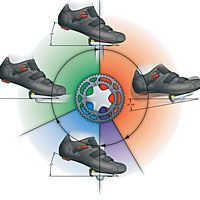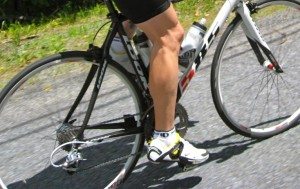Force is simply defined as the ability to overcome resistance. On the bike, this typically means having the ability to overcome a headwind or battle the force of gravity on a climb. Unsurprisingly, force tends to be one of the major limiters to many riders' successes when they get out into group rides and races later in the year. Thankfully, it is quite easy to work on the force portion of your riding skills both indoor and out, and cycling force work is easy to plan.
Click through for some information on cycling force work and how you can improve your force output.
 Preparation
Preparation
When talking about cycling, force is basically your ability to turn a big gear. Your preparation should start early in the off season with some cross training. Gym workouts, functional strength training, and explosive strength training are a solid foundation for bike work later in the season. During the base building phase is the perfect time to begin force work on the bike. You will continue to integrate these workouts and build on them as the season progresses. Note that speed skills and these force workouts form the basis of the “power” workouts that will be programmed later on, so putting in the time now is important for your later season workouts.
Moderate Cycling Force Efforts
Essentially, you'll be starting on the trainer or rollers, and you'll be working on more “moderate” efforts during your force intervals. Workouts will include lower cadence work (always focusing on your pedal stroke during the workout) and higher resistances. You may well be riding in your big chainring and the lower end of your cassette for 3-4 minute intervals in order to develop fatigue resistance in your muscles. These moderate efforts should be done seated, with your cadence between 70 and 85 RPM (to simulate hill climbing.) If you're riding outside, think about riding 6% average grade hills that last 3-4 minutes (seated,) and keep your climbing cadence between 70 RPM and 85 RPM. Importantly, note that these are not all out climbs; you'll want to tickle your threshold, but not exceed it.
Once you've moved out of your base period and are looking to build on the gains you've made early on, you can consider “long” efforts and “steep” efforts. These both imitate situations in races or group rides that can split the group.
Long Cycling Force Efforts
For longer hills, look for terrain that affords you a six minute or longer interval with a grade between 6% and 8%. Do your intervals mostly seated, but don't be afraid to stand in order to give your muscles some rest by changing position. You'll want to do these intervals between 60 RPM and 80 RPM (if your preferred climbing cadence is higher than 80 RPM these will feel like a horrible grind; if your preferred cadence falls between 60 RPM and 80 RPM, use that cadence.) These efforts should stay around your threshold, but don't get careless and let your effort skyrocket. Concentrate on your body position, relaxing the shoulders to allow for unrestricted breathing and keeping your pedal stroke fluid and smooth.
 Short, Steep Cycling Force Efforts
Short, Steep Cycling Force Efforts
Steep hills present more of a challenge. You'll typically look for hills that take you less than two minutes to crest. Keep an eye out for climbs that are double digit gradients (10% or steeper.) You'll want to do several efforts either on the same hill or on several hills, but with plenty of rest in between. These are hard efforts which will take you well over functional threshold power and you'll be climbing both seated and standing. Cadence should be between 50 RPM and 65 RPM, but immediately scrap the workout if you have trouble maintaining 50 RPM at minimum. Also, note that anyone with knee issues may want to avoid this workout as it will put stress on the knee joint.
Building On Force Work
As your season progresses you'll start doing work in the “power” paradigm which combines pedal stroke drills with the ability to push a big gear (think time trialling or sprinting.) You'll also use the fitness gained by doing force work in the “muscular endurance” paradigm which helps you push bigger gears for longer periods of time (such as when climbing and time trialling.)
Do yourself a favor and don't skimp on the early season work, or you'll be regretting it later in the year.